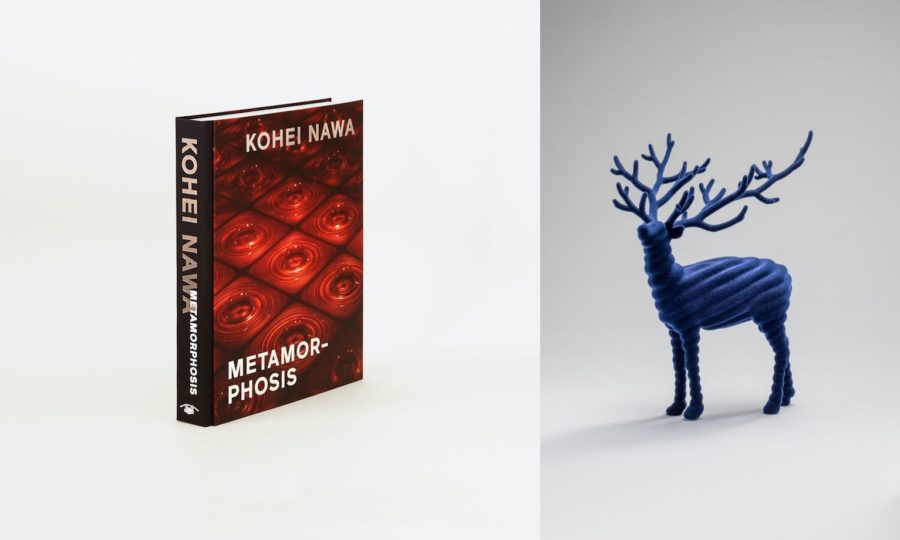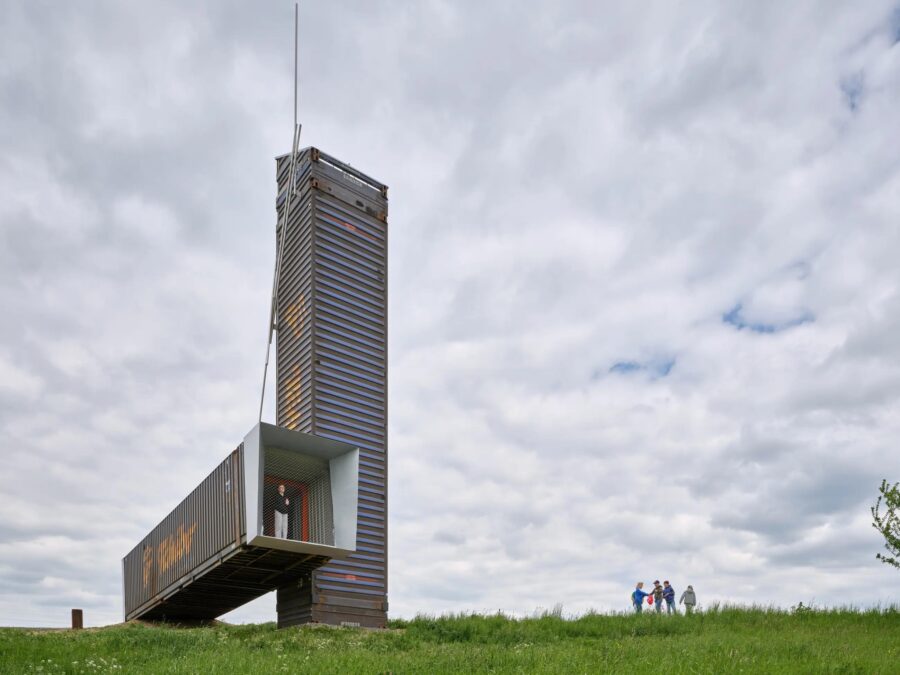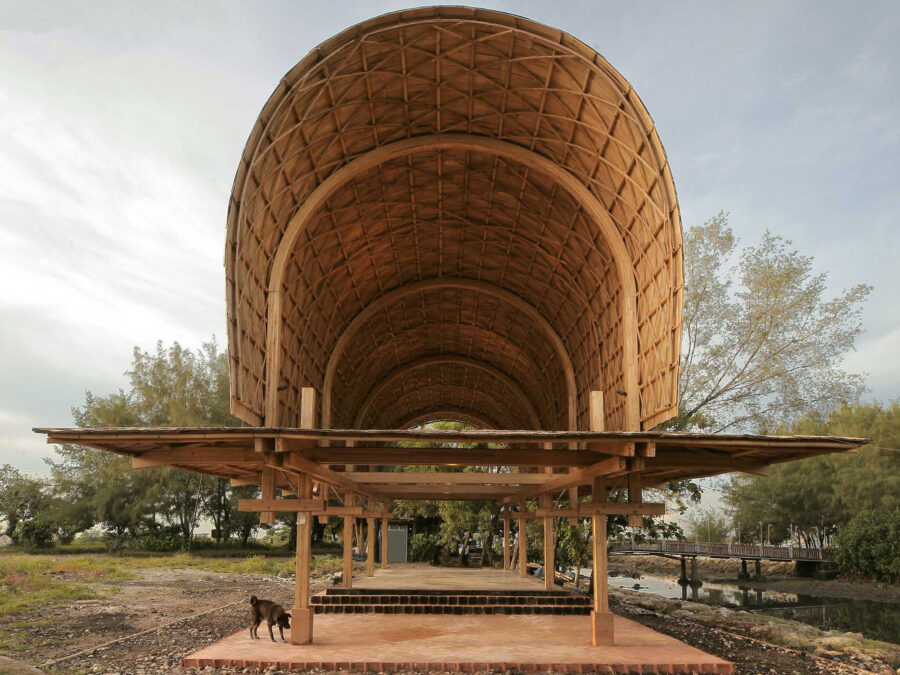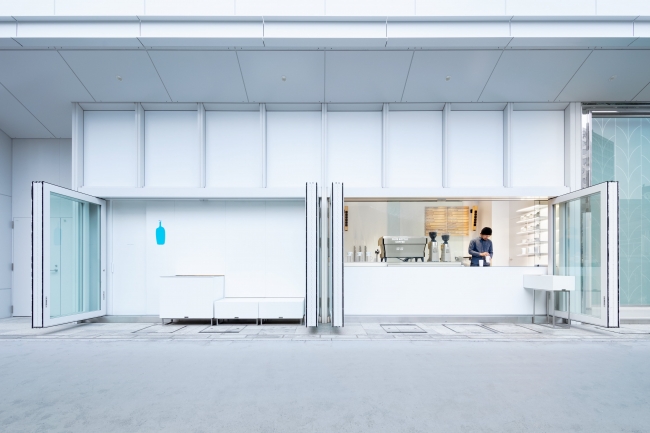
CULTURE


© Su Chen, Chun Fang

© Su Chen, Chun Fang
中国の北京林業大学の敷地内に建つ〈Swirling Cloud〉は、ガーデン・フェスティバルのために建てられ、期間後は学生や教師の集いの場として機能している、竹で構築された流れるようなデザインのパビリオンです。
柔軟性と曲げ耐性という竹の特性を活かしつつ、デジタル・シミュレーションやプレファブリケーションといった現代的なアプローチと伝統的な職人技を融合した設計プロセスにより、竹建築の可能性を提示しています。
中国の設計事務所 SUPアトリエ(SUP Atelier)が設計しました。
(以下、SUP Atelierから提供されたプレスキットのテキストの抄訳)

© Su Chen, Chun Fang

© Su Chen, Chun Fang
北京林業大学のガーデン・フェスティバルのために建てられたパビリオン
北京林業大学キャンパス内の小さな森に位置する〈Swirling Cloud〉は、教授陣の依頼を受け、2018年のバンブー・ガーデン・フェスティバルのためにデザインされた、120m²の面積を有する竹のパビリオンである。 イベント終了後は、学生や教師がくつろいだり、ちょっとした集まりができるフレキシブルな屋外スペースとなっている。
北側と西側はキャンパス内の道路に面した敷地は、樹木や低木、記念の石碑、ベンチに囲まれたらせん状の広場であり、パビリオンは広場の中央に位置している。

© Su Chen, Chun Fang

© Su Chen, Chun Fang
竹の利点「柔軟性と曲げ耐性」を活かした建築
敷地の周辺環境から、デザインに対する制約がほとんどなかったため、私たちは設計プロセスは竹そのものの特性からスタートし、デザインに大きな柔軟性を与えることができた。
構造材に最も適した材料の1つである竹は、木材よりもさらに際立った特徴を有している。

© Su Chen, Chun Fang

© Su Chen, Chun Fang
生の竹は曲げや引っ張りの特性に優れ、曲げ加工が容易であり、近代的な竹の加工技術と組み合わせることで、工場でも現場でも制御された整形を行うことが容易である。また、整形および乾燥後、屋外に置いても変形しにくい。
このような柔軟な設計条件と竹の曲げ加工適性が相まって、キャンパス環境やガーデン・フェスティバルの雰囲気にマッチした、自由で伸びやかなフォルムを実現し、デザインの可能性を提示している。

© Su Chen, Chun Fang
風と雲をコンセプトとしたデザインを実現するデザインプロセス
竹の原型と現代建築技術を組み合わせ、まず概念的なプランを持ち、デジタルツールを使って全体としての構造を逆生成し、設計手法の建設を導くことを試みている。
有名な漢詩の一節に、「風は昇り、雲は飛ぶ」というものがある。この一節からインスピレーションを得たデザインチームは、吹き上がる風と舞い上がる雲をパビリオンのフォルムで表現することを試みた。

© Su Chen, Chun Fang

© Su Chen, Chun Fang
〈Swirling Cloud〉には、生の竹を使う工法と現代の建築技術を融合させた設計プロセスを採用しており、まずコンセプトデザインとデジタル・シミュレーションによって全体的な構造を決定した。このデジタル・ドキュメントは、現場での建設にも利用できる。
デジタル化が設計と施工の全プロセスに適用されたことにより、竹のパーツは制御可能な条件下で成形や曲げ加工を行うことのできる工場でプレファブリケーション化され、現場で組み立てられた。
このようにして、コンセプトデザインは正確に実現された。また、デジタル技術の助けを借り、湾曲した外壁と主要な竹の梁の曲線は、構造の応力や建築の慣習に適合することが可能となった。

© Su Chen, Chun Fang
周辺道路の方向や樹木、茂み、記念碑の位置に合わせて、パビリオンにはさまざまな高さの開口部を設け、来場者が自由なルートからパビリオンを通り抜けられるようにした。
また、既存の生け垣をパビリオンの内部空間まで延長し、パビリオンの上部に円形の開口部を設け、風や自然光、緑を内部に取り込んだ。これにより天蓋の鈍重さを打ち破り、雲の渦を連想させる、圧迫感のない空間を実現した。

© Su Chen, Chun Fang

© Su Chen, Chun Fang
コンセプトプランからデジタルモデルを導入し、構造エンジニアや竹施工業者と施工ロジックを整理した後、主要部分のデジタルモデルを段階的に生成していった。
まず、さまざまな開口部と天窓を含むパビリオンの基本的な曲線の位置と形状を入力し、曲線の屋根と中央の円錐を生成した。
次に、経験則から推定した梁の間隔に基づいて、すべての曲線の梁を生成し、その上に竹割りの交差グリッドを敷き、屋根のすべての構造部分を一体化させ、最後に、雨よけと採光の必要性を考慮し、竹瓦とプレキシガラスパネルの2種類の曲面屋根材を使用した。

© Su Chen, Chun Fang
職人技と現代的なアプローチの融合を実現する構造解析と詳細設計
生の竹による構造には、特に竹の豊富な中国南部では古くから住宅や橋に多く使用されてきた歴史があり、明確な構造計算をせずとも、竹施工業者や構造エンジニアの経験から建設要件を満たすことができた。この経験を活かし〈Swirling Cloud〉の寸法、構造形態、接合部は、施工業者や構造エンジニアとともに決定した。
竹の梁は、デジタル・シミュレーションによってパラメータが決定され、工場でプレハブ加工され、番号が振られた後、現場で組み立てられた。この竹の梁と地面は、金具と現場打ちコンクリート基礎で連結され、異なる方向の梁は、竹建築の伝統的な手法で接続された。

© Su Chen, Chun Fang
竹瓦とプレキシガラスパネルは自然採光や雨よけの必要性、そして部分的に湾曲した屋根で親密な雰囲気をつくり出そうという意図を考慮し選定され、竹瓦の下には防水膜と葦マットを敷いた。
パビリオンの中央の円錐形は、支持構造であると同時に、自然光と人工光の通り道でもある。敷地内には透水性の砂利を敷き詰め、小石の浸透ピットを点在させることで、竹の梁と地面が接する部分に水が溜まるのを防いだ。

© Su Chen, Chun Fang
伝統的な竹の職人技と現代的な技術を融合させた設計プロセスにより、木造や鉄骨造のプレファブ建築の精密な製造とは異なり、詳細設計ではある程度の誤差を許容し、伝統的な職人技の特徴を残している。
このプロジェクトの建設ロジックは、現代に適応する再現可能なプロトタイプを探求しており、竹によるデザインの優れた柔軟性により、異なる土地に適用・修正されていくことを期待している。

© Su Chen, Chun Fang

© Su Chen, Chun Fang

© Su Chen, Chun Fang

Explosion diagram

Plan

Elevations

Section
以下、SUP Atelierのリリース(英文)です。
Project name: Swirling Cloud: Bulletin Pavilion for BJFU Garden Festival
Architect’ Firm: SUP Atelier
Website: http://www.supatelier.com/cnArchitects Team: Yehao Song, Xiaojuan Chen, Jingfen Sun, Dan Xie, Mengjia Liu, Yingnan Chu, Haowei Yu, Shaohang Shi
Project location: Beijing Forestry University
Completion Year: 2018
Gross Built Area (square meters): 120m²Photo credits: Su Chen, Chun Fang
Lighting Design: X Studio, School of Architecture, Tsinghua University
Bamboo Contractor: Anji Zhujing Bamboo Technology Co., Ltd
Clients: Beijing Forestry UniversitySwirling Cloud: Bulletin Pavilion for BJFU Garden Festival
Located in a grove in the campus of BJFU, the “pavilion of clouds” is a bamboo structure built for 2018 “Bamboo Garden Festival”, and the project was commissioned by the faculty of BJFU. Covering an area of approximately 120 square meters, the pavilion will serve as a hub for information during the festival, and turn into a flexible place for recreation and gathering when the event is over.
Bordering campus roads on its north and west, the site is a spiral square enclosed by groves, bush-es, memorial stone carvings and benches, and the pavilion is situated in the center of the square.Flexibility & Bending Resistance: Advantages of Bamboo
We were granted with great flexibility for the design, as the surroundings of the site posed few re-strictions to the design. As a result, our design process started with the feature of bamboo itself.
As one of the most suitable structural materials, bamboo has even more distinctive features than wood. With excellent bending resistance and tensile resistance, raw bamboo is easy to be bent or pro-cessed. With the help of modern bamboo processing technology, controllable sizing and processing of bamboo can be done in factories or even on site. Besides, the processed bamboo isn’t prone to defor-mation outdoors once it is dried and shaped.
The favorable site conditions and the advantages of bamboo granted us with the possibility of a free and relaxed form with a sense of strength, which complied with both the style of the campus and the atmosphere of the garden festival.Clouds in the Gale: A Design Process of Generating Building Elements Reversely
A famous verse in an ancient Chinese poem says, “A gale has risen and is sweeping the clouds across the sky.” Inspired by this verse, the design team intended to present the image of rising wind and flying clouds with the pavilion’s form. In the design process, where raw bamboo construction methods were integrated with modern building technologies, a conceptual design was made first, and the overall structure was generated through digital simulation. Those digital documents could also be used for on-site construction. Compared with the traditional simulation method of making a small physical model, our approach had several advantages. On one hand, digitalization was applied to the whole design & construction process. Bamboo parts were prefabricated in factories where shaping and bending were done under controllable conditions, and then assembled on site. In this way, the conceptual design was implemented precisely. On the other hand, with the help of digital technology, the curved envelope and the curve of key bamboo beams were made more compliant with the stress situation of the structure and construction conventions.
In accordance with the directions of surrounding roads, as well as the positions of trees, bushes and memorial stones, several openings at various heights were made on the pavilion, so that passengers can go through the pavilion from different routes. The existing bushes were preserved and extended to the interior space of the pavilion, and the upper part of the pavilion narrowed into a round skylight. As a result, sunlight, wind and vegetation were brought into the space, making it free from sense of oppres-sion while presenting an image of swirling clouds.
In the design process, digital models were integrated with our conceptual design. Then, after con-sultation with structural engineers and bamboo contractors on construction approaches & procedures, the digital model of key building parts were generated step by step. First, the positions and forms of fundamental curves of the pavilion, including its openings on various directions and the skylight, were input to generate the curved roof and the central cone. Then, on the basis of beam spacing estimated from experience, all the curved beams were generated, over which a crossing grid of bamboo split was laid, integrating all the structural parts of the roof into a whole. Finally, considering the demand for daylight and rain-proofing, we selected bamboo tile and PMMA as roof materials, which could both meet the demand and be applied to curved structures. Then the positioning of the curves was completed.Mortise and Tenon in Connection: Structural Analysis & Implementation of Detail Design
Raw bamboo has long been used on structures of buildings and bridges, especially in South China which abounds in bamboo. Without precise structural calculation before construction, the empirical es-timation made by the bamboo contractor and structural engineers could still meet the demand of con-struction. The pavilion’s shape, size, structural form and details were all determined by the bamboo contractor and engineers through collaboration.
Bamboo beams, the parameters of which were determined by digital simulation, were prefabricat-ed and numbered in the factory, and then assembled on site. The bamboo beam and the ground were connected by metal fittings and strip foundation of cast-in-place concrete. Beams of different directions were connected in traditional ways of bamboo construction. Considering the need of natural light, rain-proofing, as well as the intention to create an atmosphere of intimacy with the partly curved roof, we selected bamboo tile and PMMA as roof materials with waterproof membrane and reed mats under-neath. The pavilion’s central cone was not only a supporting structure, but also a channel for daylight and artificial light. Sloped paving of permeable gravels on the site, together with pebble seepage pits dotted around the site, could avoid ponding at the joints where bamboo beams and the ground meet.
In the design process where raw bamboo building techniques were combined with modern tech-nologies, there was a certain level of error tolerance for detailed design, which was different from the precise production of prefabricated wood and steel structure. Bamboo splits and tiles made it possible to make adjustments on site, rectifying small errors by the processing of raw bamboo. In this way, the handicraft features of the pavilion were also preserved.By going through the construction logic of the project, we hope that our practice has not only pre-sented a pavilion of clouds, but also explored a feasible prototype that adapts to current conditions, and can be modified for application to different sites thanks to the great flexibility of bamboo design.
「Pavilion of Clouds_Information pavilion of Beijing Forestry University Bamboo Garden」SUP Atelier 公式サイト
http://www.supatelier.com/en/projects/590









